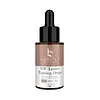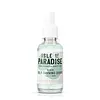What's inside
What's inside
 Key Ingredients
Key Ingredients

No key ingredients
 Benefits
Benefits

 Concerns
Concerns

No concerns
 Ingredients Side-by-side
Ingredients Side-by-side

Aloe Barbadensis Leaf Juice
Skin ConditioningDihydroxyacetone
Skin ConditioningGlycerin
HumectantErythrulose
TanningAcetyl Tyrosine
Skin ConditioningPersea Gratissima Oil
Skin ConditioningSimmondsia Chinensis Seed Oil
EmollientSqualane
EmollientCucumis Sativus Fruit Extract
EmollientChamomilla Recutita Flower Extract
MaskingCalendula Officinalis Flower Extract
MaskingCamellia Sinensis Flower Extract
PerfumingPunica Granatum Extract
AstringentVanilla Planifolia Fruit Extract
Skin ConditioningLactobacillus Ferment
Skin ConditioningCocos Nucifera Fruit Extract
EmollientPropanediol
SolventZinc Ricinoleate
Xanthan Gum
EmulsifyingCitric Acid
BufferingAloe Barbadensis Leaf Juice, Dihydroxyacetone, Glycerin, Erythrulose, Acetyl Tyrosine, Persea Gratissima Oil, Simmondsia Chinensis Seed Oil, Squalane, Cucumis Sativus Fruit Extract, Chamomilla Recutita Flower Extract, Calendula Officinalis Flower Extract, Camellia Sinensis Flower Extract, Punica Granatum Extract, Vanilla Planifolia Fruit Extract, Lactobacillus Ferment, Cocos Nucifera Fruit Extract, Propanediol, Zinc Ricinoleate, Xanthan Gum, Citric Acid
Water
Skin ConditioningDihydroxyacetone
Skin ConditioningAlcohol Denat.
AntimicrobialGlycerin
HumectantPolysorbate 80
EmulsifyingXanthan Gum
EmulsifyingErythrulose
TanningPropylene Glycol
HumectantTropaeolum Majus Flower/Leaf/Stem Extract
Skin ConditioningTocopheryl Acetate
AntioxidantAloe Barbadensis Extract
Skin ConditioningCitrus Grandis Peel Oil
MaskingCocos Nucifera Oil
MaskingEucalyptus Globulus Leaf Oil
PerfumingMentha Piperita Oil
MaskingPersea Gratissima Oil
Skin ConditioningSalvia Hispanica Seed Oil
MoisturisingSalvia Officinalis Oil
MaskingMethoxyphenyl T-Butylphenyl Propanediol
Skin ConditioningAgastache Mexicana Flower/Leaf/Stem Extract
Skin ConditioningAscorbic Acid
AntioxidantPropanediol
SolventEthylhexylglycerin
Skin ConditioningSodium Metabisulfite
AntioxidantParfum
MaskingSodium Hydroxide
BufferingPhenoxyethanol
PreservativeTriethylene Glycol
MaskingWater, Dihydroxyacetone, Alcohol Denat., Glycerin, Polysorbate 80, Xanthan Gum, Erythrulose, Propylene Glycol, Tropaeolum Majus Flower/Leaf/Stem Extract, Tocopheryl Acetate, Aloe Barbadensis Extract, Citrus Grandis Peel Oil, Cocos Nucifera Oil, Eucalyptus Globulus Leaf Oil, Mentha Piperita Oil, Persea Gratissima Oil, Salvia Hispanica Seed Oil, Salvia Officinalis Oil, Methoxyphenyl T-Butylphenyl Propanediol, Agastache Mexicana Flower/Leaf/Stem Extract, Ascorbic Acid, Propanediol, Ethylhexylglycerin, Sodium Metabisulfite, Parfum, Sodium Hydroxide, Phenoxyethanol, Triethylene Glycol
 Reviews
Reviews

Ingredients Explained
These ingredients are found in both products.
Ingredients higher up in an ingredient list are typically present in a larger amount.
Dihydroxyacetone, or DHA, is a simple sugar. It is frequently used in self-tanning products.
DHA binds to the amino acids in your dead skin cells to create a brown/orange color. Darkening begins to kick in a few hours after application and will continue to develop for up to 3 days. This ingredient can be drying.
Both the US and the EU have approved DHA in self-tanning products. In the EU, DHA is allowed at a maximum concentration of 10%. Most tanning products usually contain amounts between 3-5%.
If you are pregnant or have underlying medical conditions, it is best to speak with a dermatologist about using self-tanning products.
Learn more about DihydroxyacetoneWe don't have a description for Erythrulose yet.
Glycerin is already naturally found in your skin. It helps moisturize and protect your skin.
A study from 2016 found glycerin to be more effective as a humectant than AHAs and hyaluronic acid.
As a humectant, it helps the skin stay hydrated by pulling moisture to your skin. The low molecular weight of glycerin allows it to pull moisture into the deeper layers of your skin.
Hydrated skin improves your skin barrier; Your skin barrier helps protect against irritants and bacteria.
Glycerin has also been found to have antimicrobial and antiviral properties. Due to these properties, glycerin is often used in wound and burn treatments.
In cosmetics, glycerin is usually derived from plants such as soybean or palm. However, it can also be sourced from animals, such as tallow or animal fat.
This ingredient is organic, colorless, odorless, and non-toxic.
Glycerin is the name for this ingredient in American English. British English uses Glycerol/Glycerine.
Learn more about GlycerinPersea Gratissima Oil is also known as avocado oil.
Avocado Oil has antioxidant properties. It is mostly made up of the glycerides of fatty acids. About 67% of these fatty acids is made up of oleic acid. Palmitic acid and linoleic acid are also present.
These fatty acids help hydrate and soften the skin. It may increase collagen content in the skin. Collagen helps keep your skin plump and firm. This ingredient helps reduce inflammation and has not shown to clog pores.
This ingredient may not be fungal-acne safe due to its high fatty acid content.
Avocados also have B vitamins, vitamin K, vitamin C, vitamin E, and potassium.
Learn more about Persea Gratissima OilPropanediol is an all-star ingredient. It softens, hydrates, and smooths the skin.
It’s often used to:
Propanediol is not likely to cause sensitivity and considered safe to use. It is derived from corn or petroleum with a clear color and no scent.
Learn more about PropanediolXanthan gum is used as a stabilizer and thickener within cosmetic products. It helps give products a sticky, thick feeling - preventing them from being too runny.
On the technical side of things, xanthan gum is a polysaccharide - a combination consisting of multiple sugar molecules bonded together.
Xanthan gum is a pretty common and great ingredient. It is a natural, non-toxic, non-irritating ingredient that is also commonly used in food products.
Learn more about Xanthan Gum